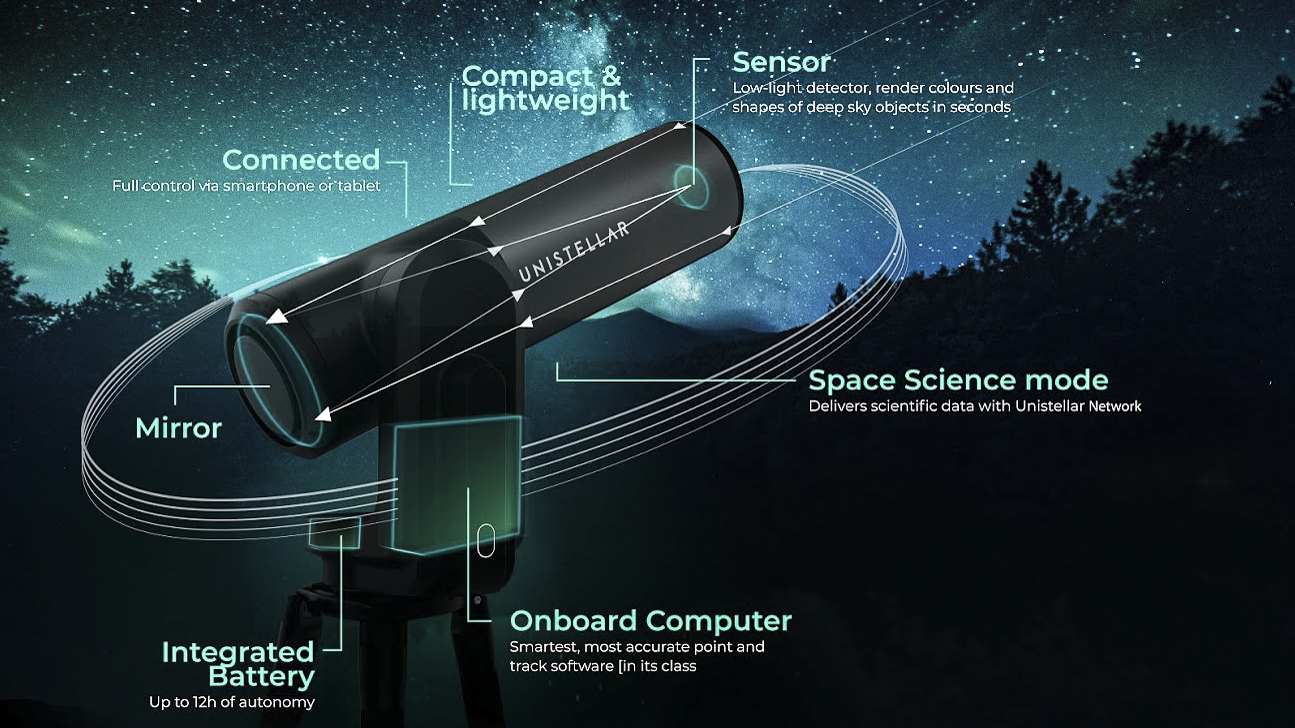Unistellar eQuinox: second gen smart telescope with Sony sensor inside
Try easy astrophotography on your smartphone or tablet on this digital telescope 'smartscope', now with a bigger battery

Telescopes have been flying off the shelves during the pandemic, but a new ‘smartscope’ could have a unique appeal to anyone thinking of trying out astrophotography.
The Unistellar eVscope eQuinox, a second-generation attempt at a ‘smart telescope’, has just been announced – but it has no eyepiece.
If you’ve ever looked through a telescope at objects in the ‘deep sky’ then you’ll know that astronomy is all about the art of collecting light. It’s also about standing around and taking your turn to look through an eyepiece.
So what if you built a telescope around a camera sensor that produced a clearer, brighter image of a galaxy, nebula, star cluster or supernova remnant the longer you pointed your telescope at it? And then let up to 10 people attach to that telescope by WiFi to view the ever-improving image on their smartphone or tablet?
That’s the idea behind the eVscope eQuinox, which is available on pre-order from today for €2,799 (approximately US$3,336 or £2,411) with the first devices expected to be delivered in May 2021.

Essentially an astrophotography set-up ‘in a box’, the eVscope eQuinox is the follow-up to the original Unistellar eVscope, and a rival to the rival smart telescope, the Vaonis Stellina, but it comes with improvements.
Like the original Unistellar eVscope the eVscope eQuinox is built around a Sony Exmoor IMX224 imaging sensor. Its 65cm tube is mounted on a motorized alt-azimuth arm and motor. It’s also fitted with the same 114mm/4.5 inch diameter mirror as the original so has an identical focal length of 450mm, and a focal ratio of f4.
The best camera deals, reviews, product advice, and unmissable photography news, direct to your inbox!
However, whereas the original’s lithium-ion battery was only good for nine hours, the eVscope eQuinox’s is said to keep going for 12 hours – because there's no longer an eyepiece. It recharges via a USB-C slot, which can also be used the other way to recharge a smartphone or tablet.
That longer battery, says Unistellar, makes the eQuinox easier to use to make longer observations. That’s crucial if you want to use it to join in with ‘citizen science’ missions with some of the nearly 5,000 owners of the first-gen version across Europe, Japan and North America.
Unistellar runs various projects in conjunction with the SETI Institute, a recent success being the capturing of Apophis Asteroid by a community of amateur astronomers using the original Unistellar eVscope. As well as detecting hazardous asteroid it’s possible to use the eVscope eQuinox to discover and confirm the existence of ‘hot Jupiter’ exoplanets around distant stars and study comets and supernovae.
Just as critical is that the eVscope eQuinox is easy to set-up. Its ‘autonomous field detection’ software means it recognizes stars, so the alignment procedure is fully automated and takes just 10 seconds, according to Unistellar.
Using the connected smartphone as its point of reference, the eVscope eQuinox then uses its built-in catalogue of 5,400 objects to recommend targets based on the time, date and location of your smartphone.
“With the eVscope eQuinox you can be that Earth-saving scientist from an action movie – you can travel distant galaxies and hunt for new worlds,” says Laurent Marfisi, Unistellar’s chief executive officer. “Best of all, you are not alone on your space adventure. You have got 5,000 crew-members in the Unistellar network, right by your side.”
Read more
Vaonis Stellina smart telescope review
The best telescopes in 2021
The best camera for astrophotography
The best CCD cameras for astrophotography
The best lenses for astrophotography
The best light pollution filters for astrophotography

Jamie has been writing about photography, astronomy, astro-tourism and astrophotography for over 15 years, producing content for Forbes, Space.com, Live Science, Techradar, T3, BBC Wildlife, Science Focus, Sky & Telescope, BBC Sky At Night, South China Morning Post, The Guardian, The Telegraph and Travel+Leisure.
As the editor for When Is The Next Eclipse, he has a wealth of experience, expertise and enthusiasm for astrophotography, from capturing the moon and meteor showers to solar and lunar eclipses.
He also brings a great deal of knowledge on action cameras, 360 cameras, AI cameras, camera backpacks, telescopes, gimbals, tripods and all manner of photography equipment.
